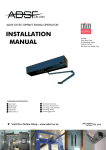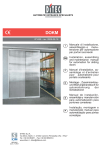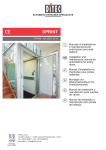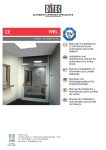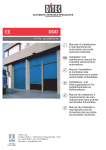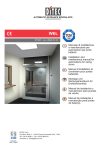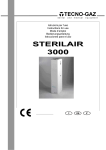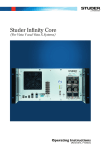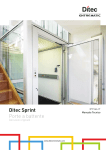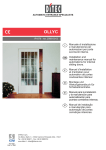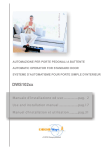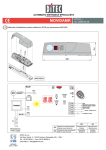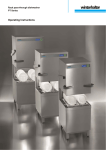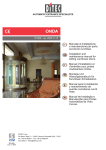Download SPRINT - ZeroCat
Transcript
SPRINT IP1546 - rev. 2007-12-12 I GB F D E P DITEC S.p.A. Via Mons. Banfi, 3 - 21042 Caronno Pertusella (VA) Distribuzione: DONATI SRL via Ponchielli 2Cernusco s/N MI - Italy tel +39 02 9240133 Fax +39 02 9240135 www.donati.it - [email protected] Manuale di installazione e manutenzione per automazioni per porte battenti. Installation and maintenance manual for automations for swing doors. Manuel d’installation et d’entretien pour portes battantes. Montage und Wartungshandbuch für Drehtürenantrieb. Manual de instalaciòn y manutenciòn para puertas de vaivén. Manual de instalação e manutenção para portas de balanço. 1 2 2 2x 4x 1.5 0.5 mm 2 mm 2 3 4 Fig. 1 450 80 90 7 7 1 8 5 6 8 60 9 8 260 168 8 Fig. 2 SPRINT - IP1546 2 AVVERTENZE GENERALI PER LA SICUREZZA DIRETTIVA MACCHINE Il presente manuale di installazione è rivolto esclusivamente a personale professionalmente competente. L’installazione, i collegamenti elettrici e le regolazioni devono essere effettuati nell’osservanza della Buona Tecnica e in ottemperanza alle norme vigenti. Leggere attentamente le istruzioni prima di iniziare l’installazione del prodotto. Una errata installazione può essere fonte di pericolo. I materiali dell’imballaggio (plastica, polistirolo, ecc.) non vanno dispersi nell’ambiente e non devono essere lasciati alla portata dei bambini in quanto potenziali fonti di pericolo. Prima di iniziare l’installazione verificare l’integrità del prodotto. Non installare il prodotto in ambiente e atmosfera esplosivi: presenza di gas o fumi infiammabili costituiscono un grave pericolo per la sicurezza. Prima di installare la motorizzazione, apportare tutte le modifiche strutturali relative alla realizzazione dei franchi di sicurezza ed alla protezione o segregazione di tutte le zone di schiacciamento, cesoiamento, convogliamento e di pericolo in genere. Verificare che la struttura esistente abbia i necessari requisiti di robustezza e stabilità. Il costruttore della motorizzazione non è responsabile dell’inosservanza della Buona Tecnica nella costruzione degli infissi da motorizzare, nonché delle deformazioni che dovessero intervenire nell’utilizzo. I dispositivi di sicurezza (fotocellule, coste sensibili, stop di emergenza, ecc.) devono essere installati tenendo in considerazione: le normative e le direttive in vigore, i criteri della Buona Tecnica, l’ambiente di installazione, la logica di funzionamento del sistema e le forze sviluppate dalla porta o cancello motorizzati. I dispositivi di sicurezza devono proteggere eventuali zone di schiacciamento, cesoiamento, convogliamento e di pericolo in genere, della porta o cancello motorizzati. Applicare le segnalazioni previste dalle norme vigenti per individuare le zone pericolose. Ogni installazione deve avere visibile l’indicazione dei dati identificativi della porta o cancello motorizzati. Prima di collegare l’alimentazione elettrica accertarsi che i dati di targa siano rispondenti a quelli della rete di distribuzione elettrica. Prevedere sulla rete di alimentazione un interruttore/sezionatore onnipolare con distanza d’apertura dei contatti uguale o superiore a 3 mm. Verificare che a monte dell’impianto elettrico vi sia un interruttore differenziale e una protezione di sovracorrente adeguati. Quando richiesto, collegare la porta o cancello motorizzati ad un efficace impianto di messa a terra eseguito come indicato dalle vigenti norme di sicurezza. Durante gli interventi di installazione, manutenzione e riparazione, togliere l’alimentazione prima di aprire il coperchio per accedere alle parti elettriche. La manipolazione delle parti elettroniche deve essere effetuata munendosi di bracciali conduttivi antistatici collegati a terra. Il costruttore della motorizzazione declina ogni responsabilità qualora vengano installati componenti incompatibili ai fini della sicurezza e del buon funzionamento. Per l’eventuale riparazione o sostituzione dei prodotti dovranno essere utilizzati esclusivamente ricambi originali. L’installatore deve fornire tutte le informazioni relative al funzionamento automatico, manuale e di emergenza della porta o cancello motorizzati, e consegnare all’utilizzatore dell’impianto le istruzioni d’uso. Ai sensi della Direttiva Macchine (98/37/CE) l’installatore che motorizza una porta o un cancello ha gli stessi obblighi del costruttore di una macchina e come tale deve: - predisporre il fascicolo tecnico che dovrà contenere i documenti indicati nell’Allegato V della Direttiva Macchine; (Il fascicolo tecnico deve essere conservato e tenuto a disposizione delle autorità nazionali competenti per almeno dieci anni a decorrere dalla data di costruzione della porta motorizzata); - redigere la dichiarazione CE di conformità secondo l’Allegato II-A della Direttiva Macchine e consegnarla al cliente; - apporre la marcatura CE sulla porta motorizzata ai sensi del punto 1.7.3 dell’Allegato I della Direttiva Macchine. Per maggiori informazioni consultare le “Linee guida per la realizzazione del fascicolo tecnico” disponibile su internet al seguente indirizzo: www.ditec.it INDICAZIONI DI UTILIZZO Classe di servizio: 5 (minimo 5 anni di utilizzo con 600 cicli al giorno) Utilizzo: MOLTO INTENSO (per ingressi di tipo collettivo con uso carraio o pedonale molto intenso) - Le prestazioni di utilizzo si riferiscono al peso raccomandato (circa 2/3 del peso massimo consentito). L’utilizzo con il peso massimo consentito potrebbe ridurre le prestazioni sopra indicate. - La classe di servizio, i tempi di utilizzo e il numero di cicli consecutivi hanno valore indicativo. Sono rilevati statisticamente in condizioni medie di utilizzo e non possono essere certi per ogni singolo caso. Si riferiscono al periodo nel quale il prodotto funziona senza necessità di manutenzione straordinaria. - Ogni ingresso automatico presenta elementi variabili quali: attriti, bilanciature e condizioni ambientali che possono modificare in maniera sostanziale sia la durata che la qualità di funzionamento dell’ingresso automatico o di parte dei suoi componenti (fra i quali gli automatismi). E’ compito dell’installatore adottare coefficienti di sicurezza adeguati ad ogni particolare installazione. DICHIARAZIONE DEL FABBRICANTE (Direttiva 98/37/CE, Allegato II, parte B) Fabbricante: DITEC S.p.A. Indirizzo: via Mons. Banfi, 3 - 21042 Caronno P.lla (VA) - ITALY Dichiara che l’automazione per porte battenti serie SPRINT - è costruito per essere incorporato in una macchina o per essere assemblato con altri macchinari per costituire una macchina considerata dalla Direttiva 98/37/CE; - è conforme alle condizioni delle seguenti altre direttive CE: Direttiva compatibilità elettromagnetica 89/336/CEE; Direttiva bassa tensione 73/23/CEE; e inoltre dichiara che non è consentito mettere in servizio il macchinario fino a che la macchina in cui sarà incorporata o di cui diverrà componente sia stata identificata e ne sia stata dichiarata la conformità alle condizioni della Direttiva 98/37/CE e alla legislazione nazionale che la traspone. Caronno Pertusella, 26-01-1998 3 Fermo Bressanini (Presidente) SPRINT - IP1546 I 1. DATI TECNICI Alimentazione Assorbimento Coppia Tempo di apertura e di chiusura Intermittenza Alimentazione accessori Tipo di funzionamento Temperatura Grado di protezione Quadro elettronico Indicazioni di utilizzo m = lunghezza anta kg = peso anta SPRINT 230 V~ / 50-60 Hz 0,2 A 25 Nm min 7 s / 90° max 3 s / 90° S2 = 30 min S3 = 80% 24 V= / 0,15 A Apertura a motore Chiusura a motore -20 °C / +55 °C [batterie: +10 °C / +50 °C] IP12D 165 SPRINTJ 120 V~ / 60 Hz 0,4 A 25 Nm min 7 s / 90° max 3 s / 90° S2 = 30 min S3 = 80% 24 V= / 0,15 A Apertura a motore Chiusura a motore -20 °C / +55 °C [batterie: +10 °C / +50 °C] IP12D 165 150 kg 100 kg Dimensioni raccomandate 50 kg Dimensioni limite 2. 0,5 RIFERIMENTI ILLUSTRAZIONI 1 1,5 m 3.2 Installazione con braccio articolato Usare il braccio articolato per porte che aprono all’esterno vista lato automazione. La garanzia di funzionamento e le prestazioni dichiarate si ottengono solo con accessori e dispositivi di sicurezza DITEC. min 550 2.1 Riferimenti installazione tipo (fig. 1) [1] [2] [3] [4] Motoriduttore Radar Collegare all’alimentazione tramite l’apposita spina. Il collegamento alla rete deve avvenire su canala indipendente e separata dai collegamenti ai dispositivi di comando e sicurezza. Battuta meccanica di apertura 2.2 Riferimenti automazione (fig. 2) [5] [6] [7] [8] [9] Quadro elettronico Interruttore di accensione/spegnimento Carter Supporto bracci Piastra di base 3. INSTALLAZIONE - Tutte le misure riportate sono espresse in mm, salvo diversa indicazione. Togliere il carter e fissare l’automazione a parete rispettando le misure indicate in figura: fare riferimento all’asse cerniere. Controllare la stabilità, il peso dell’anta e che il movimento sia regolare e senza attriti (se necessario rinforzare il telaio). Eventuali “chiudi porta” devono essere eliminati o, in alternativa, completamente annullati. Attenzione: verificare il corretto funzionamento nei casi di installazione su porte che dividono ambienti a pressioni diverse. SPRINT - IP1546 max 30 3.1 Controlli preliminari 44 I OPEN max 300 4 B - 3.3 Installazione con braccio scorrevole Assemblare il braccio articolato, senza serrare le viti di escursione [A], e fissarlo all’automazione facendo attenzione che si inserisca nella sede del supporto bracci. B Usare il braccio scorrevole per porte che aprono all’interno vista lato automazione. A min 650 - Fissare la staffa [B] alla porta. Togliere il carter e fissare l’automazione a parete rispettando le misure indicate in figura: fare riferimento all’asse cerniere. B 29 34 44 max 45 46 320 OPEN Con porta chiusa eseguire la regolazione del braccio e serrare le viti [A]. - Forare la guida [C] e fissarla alla porta. C B 34 - C 90-100° 500 A - 150 Inserire il pattino [D] del braccio scorrevole nella guida [C]. Fissare il braccio all’automazione facendo attenzione che si inserisca nella sede del supporto bracci. Inserire il coperchio [E] e le due testate [F]. F C D F min 10° E 5 SPRINT - IP1546 I 3.4 Installazione con braccio articolato SPRINTBRAS - Usare il braccio articolato SPRINTBRAS per porte che aprono verso l’interno vista lato automazione. min 650 Per distanze comprese tra 45 mm e 20 mm togliere il braccio [F] e fissare il braccio [G] alla staffa [E] con il distanziale e la vite in dotazione, in modo da formare sempre un angolo compreso tra 80÷90° rispetto al braccio [M]. E M G max 45 min 650 340 80-90° - La distanza di fissaggio dell’automatismo rispetto all’anta può essere compresa tra 185 mm e 45 mm. max 45 74 34 220 74 OPEN 3.5 Installazione fermo porta OPEN Fissare a pavimento il fermo porta in dotazione come battuta meccanica in apertura. 34 max 185 250 340 - Regolare la lunghezza dei bracci [E] ed [F] in modo da formare un angolo di 80÷90° rispetto al braccio [M], a porta chiusa. N.B.: il braccio articolato SPRINTBRAS è assemblato per anta con apertura a sinistra, nel caso di anta con apertura a destra, separare il braccio [G] dal braccio [M] (rimuovendo la spina) e riassemblare i due bracci ruotati di 180°. min 650 340 E max 185 I M F G 80-90° max 395 SPRINT - IP1546 6 COLLEGAMENTI ELETTRICI BATTERY 12V / 1.2Ah I Fuse 5A TC T1 VM T2 15 0 1 2 3 8 9 C EN +M - M ON +B - B TRANSF 1 2 3 4 4. POWER ALARM M= Alimentazione Power supply T1-T2 - Uscita / Output + 24 V= / 0.15 A RADAR RADAR 165 Attenzione: ponticellare tutti i contatti N.C. se non utilizzati. 4.1 Comandi 1 Comando 2 N.O. 1 1 3 8 N.O. N.C. 1 9 N.C. Funzione CHIUSURA CHIUSURA AUTOMATICA APERTURA SICUREZZA DI INVERSIONE STOP Descrizione La chiusura del contatto attiva la manovra di chiusura. Un contatto permanente abilita la chiusura automatica. La chiusura del contatto attiva la manovra di apertura. L’apertura del contatto provoca l’inversione del movimento (riapertura) durante la fase di chiusura. L’apertura del contatto provoca l’arresto di qualsiasi movimento e l’esclusione di ogni funzione normale o di emergenza. 4.2 Uscite e accessori Uscita 1 0 Valore + - 24 V= / 0,15 A Descrizione Alimentazione accessori. Uscita per alimentazione accessori esterni (compresi accessori collegati ai connettori T1 e T2). Elettroserratura. 0 15 +B -B T1-T2 12 V / 1,2 A (max) 12 V / 1,2 Ah Kit batterie. L’automazione è dotata di batteria che garantisce il funzionamento in modo continuità anche in mancanza di rete. Per caricare le batterie, collegare la rete e le batterie almeno 30 min prima di avviare l’impianto. Per disalimentare il quadro elettronico si deve togliere l’alimentazione e scollegare le batterie. Attenzione: per consentire la ricarica, le batterie devono essere sempre collegate al quadro elettronico. Verificare periodicamente l’efficienza della batteria. N.B.: la temperatura di funzionamento delle batterie ricaricabili è di circa +5°C/+40°C. Per garantire il corretto funzionamento del prodotto è opportuno installare le batterie all’interno di ambienti climatizzati. Connettori per collegamento di accessori di comando esterni (esempio: radar RER). Attenzione: per l’utilizzo di radar RER posizionare il dip-switch del radar in posizione DX. Interruttore ON-OFF. Interruttore di accensione/spegnimento. All’accensione (posizione ON) la prima manovra viene eseguita con acquisizione delle quote di battuta. Allo spegnimento (posizione OFF) l’alimentazione di linea e le batterie sono scollegate da quadro elettronico. 7 SPRINT - IP1546 I 4.3 Trimmer TC VM Descrizione Tempo chiusura automatica. Regola il tempo che intercorre tra la fine della manovra di apertura e l’inizio della chiusura automatica. N.B.: con DIP1=ON impostare TC>5 s. Regolazione velocità di apertura e chiusura. MIN. MAX. 0s 30 s 7 s/90° 3 s/90° 4.4 Dip-Switch Descrizione DIP1 Forza di azionamento. Normale. [25 Nm] DIP2 Funzione elettroserratura. OFF Con automazione chiusa è presente una corrente di spinta permanente. L’impulso di azionamento viene dato contemporaneamente alla partenza della manovra di apertura. DIP3 Push&Go. Disabilitato. Apertura a sinistra. DIP4 Selezione senso di marcia. Il senso di apertura va considerato guardando l’automazione dal lato ispezionabile. ON Low energy. [16 Nm] N.B.: per utilizzare l’automazione in condizioni di massima sicurezza (esempio: passaggio disabili): - impostare TC>5 s - impostare VM=5 s/90° Con automazione chiusa prima della manovra di apertura viene introdotta una spinta in chiusura contemporaneamente all’impulso di azionamento. Durante la manovra di chiusura la velocità aumenta leggermente per garanrire la corretta chiusura dell’elettroserratura. Abilitato. Apertura a destra. 4.5 Segnalazioni LED POWER ALARM Acceso Presenza di alimentazione 24 V=. Lampeggiante Anomalia encoder / automazione. 4.6 Requisiti delle porte per passaggio disabili Se l’automazione SPRINT viene utilizzata su porte per passaggio disabili, regolare il trimmer VM in modo che i tempi di apertura e chiusura (escluso rallentamento) siano uguali o superiori a quelli indicati in tabella. Lunghezza anta 750 mm 850 mm 1000 mm 1200 mm 50 kg 3,0 s 3,1 s 3,2 s 3,8 s Peso anta 70 kg 3,2 s 3,2 s 3,7 s 4,5 s 60 kg 3,1 s 3,1 s 3,4 s 4,2 s 80 kg 3,3 s 3,4 s 4,0 s 4,8 s 90 kg 3,5 s 3,6 s 4,2 s 5,1 s Effettuare inoltre le regolazioni indicate in figura: APERTURA Attendere ≥ 5 s - Regolare TC t ≥ 4s t ≥ 3s (vedere tabella) regolare VM t ≥ 3s (vedere tabella) regolare VM ~80° SPRINT - IP1546 CHIUSURA 10° min 8 t ≥ 1,5s 5. 5.1 5.2 5.3 5.4 5.5 5.6 5.7 5.8 5.9 6. AVVIAMENTO Attenzione: le manovre relative al punto 5.4 avvengono senza sicurezze. E’ possibile regolare i trimmer solo ad automazione ferma. Impostare DIP1 in funzione del tipo di forza da impostare, DIP2 in funzione dell’elettroserratura installata, DIP3=OFF e DIP4 in funzione del senso di apertura. Regolare il trimmer VM a 1/4 di rotazione e TC al massimo. Ponticellare le sicurezze (1-8, 1-9). Dare alimentazione e con successivi comandi 1-2 e 1-3 verificare il corretto funzionamento dell’automazione. Regolare con il trimmer VM la velocità dell’automazione. Attenzione: ad ogni accensione il primo movimento di apertura o chiusura viene eseguito a bassa velocità e permette l’apprendimento delle quote di battuta (acquisizione). Valutare i rischi presenti, installare e collegare al quadro elettronico tutti i dispositivi di sicurezza necessari (1-8, 1-9), e verificarne il funzionamento. Se desiderato, regolare con TC la chiusura automatica (ponticellare contatto 1-2). Se si desidera l’apertura Push&Go, impostare DIP3=ON. Attenzione: la funzione Push&Go non può essere abilitata se DIP2=ON. Collegare gli eventuali accessori e verificarne il funzionamento. Se l’automazione incontra un ostacolo durante la corsa di chiusura, lo rileva e si riapre. Se incontra un ostacolo durante la corsa di apertura, lo rileva e si arresta. Nelle manovre successive, l’ostacolo viene considerato come nuova battuta di arresto fino a quando non viene rimosso. RICERCA GUASTI Problema Possibile causa L’automazione non apre e non Manca alimentazione. chiude. Accessori in corto circuito. Intervento Verificare che il quadro elettrico sia alimentato. (led POWER ALARM acceso). Scollegare tutti gli accessori dai morsetti 0-1 (deve essere presente tensione 24V=) e ricollegarli uno alla volta. Contatto di STOP aperto. Verificare il morsetto 9 del quadro elettronico. La porta è bloccata da chiavistelli e serrature. Verificare che l’anta si muova liberamente. Verificare il morsetto 8 del quadro elettronico. La porta apre ma non chiude. I contatti di sicurezza sono aperti. I dispositivi di sicurezza sono attivati. Verificare la pulizia e il corretto funzionamento delle fotocellule e dei dispositivi di sicurezza. I radar sono attivati. Verificare che il radar non sia soggetto a vibrazioni, non esegua false rilevazioni oppure la presenza di corpi in movimento nel suo raggio di azione. La chiusura automatica non funziona. Verificare il ponte 1-2. La porta si apre da sola. I radar sono instabili oppure rilevano corpi in Verificare che il radar non sia soggetto a vibraziomovimento. ni, non esegua false rilevazioni oppure la presenza di corpi in movimento nel suo raggio di azione. La porta apre/chiude per un Encoder guasto. Sostituire encoder. breve tratto e poi si ferma. (led POWER ALARM lampeggiante). Fili motore invertiti. Verificare i fili del motore. (led POWER ALARM lampeggiante) Sono presenti degli attriti. Verificare manualmente che l’anta si muova liberamente. Verificare inoltre che non ci siano sporcizia o sassolini sotto l’anta. Le batterie non sono efficienti. Verificare il fusibile della batteria. Togliere alimentazione di rete e verificare l’efficienza della batteria, eseguendo alcune manovre, se insufficiente sostituirla. 7. PIANO DI MANUTENZIONE (ogni 6 mesi) Togliere alimentazione e batterie e posizionare interruttore di accensione/spegnimento [7] in posizione OFF. Pulire e lubrificare le parti in movimento. Controllare la tenuta delle viti di fissaggio. Verificare tutti i collegamenti elettrici. Verificare l’efficienza della batteria. Ridare alimentazione batterie e posizionare interruttore di accensione/spegnimento [7] in posizione ON. Controllare la stabilità della porta e che il movimento sia regolare e senza attriti. Controllare lo stato dei cardini o cerniere. Controllare il corretto funzionamento di tutti i dispositivi di comando e di sicurezza. ATTENZIONE: Per le parti di ricambio fare riferimento al listino ricambi. 9 SPRINT - IP1546 I ISTRUZIONI D’USO AUTOMAZIONE PER PORTE BATTENTI SPRINT ISTRUZIONI DI SBLOCCO OFF Nei casi di manutenzione, malfunzionamento o emergenza, se si desidera disalimentare l’automazione, posizionare in OFF l’interruttore dell’automazione e movimentare la porta manualmente. Se la porta è provvista di elettroserratura usare l’apposita chiave per sbloccarla. ON Le presenti avvertenze sono parte integrante ed essenziale del prodotto e devono essere consegnate all’utilizzatore. Leggerle attentamente in quanto forniscono importanti indicazioni riguardanti la sicurezza di installazione, uso e manutenzione. È necessario conservare queste istruzioni e trasmetterle ad eventuali subentranti nell’uso dell’impianto. Questo prodotto dovrà essere destinato solo all’uso per il quale è stato espressamente concepito. Ogni altro uso è da considerarsi improprio e quindi pericoloso. Il costruttore non può essere considerato responsabile per eventuali danni causati da usi impropri, erronei ed irragionevoli. Evitare di operare in prossimità delle cerniere o organi meccanici in movimento. Non entrare nel raggio di azione della porta o cancello motorizzati mentre è in movimento. Non opporsi al moto della porta o cancello motorizzati poiché può causare situazioni di pericolo. Non permettere ai bambini di giocare o sostare nel raggio di azione della porta o cancello motorizzati. Tenere fuori dalla portata dei bambini i radiocomandi e/o qualsiasi altro dispositivo di comando, per evitare che la porta o cancello motorizzati possa essere azionata involontariamente. In caso di guasto o di cattivo funzionamento del prodotto, disinserire l’interruttore di alimentazione, astenendosi da qualsiasi tentativo di riparazione o di intervento diretto e rivolgersi solo a personale professionalmente competente. Il mancato rispetto di quanto sopra può creare situazioni di pericolo. Qualsiasi intervento di pulizia, manutenzione o riparazione, deve essere effettuato da personale professionalmente competente. Per garantire l’efficienza dell’impianto ed il suo corretto funzionamento è indispensabile attenersi alle indicazioni del costruttore facendo effettuare da personale professionalmente competente la manutenzione periodica della porta o cancello motorizzati. In particolare si raccomanda la verifica periodica del corretto funzionamento di tutti i dispositivi di sicurezza. Gli interventi di installazione, manutenzione e riparazione devono essere documentati e tenuti a disposizione dell’utilizzatore. ON OFF Installatore: DITEC S.p.A. Via Mons. Banfi, 3 21042 Caronno Pertusella (VA) Distribuzione: DONATI SRL 20063 Cernusco s/N MI Italy www.donati.it - [email protected] DA STACCARE E CONSEGNARE ALL’UTILIZZATORE AVVERTENZE GENERALI PER LA SICUREZZA GENERAL SAFETY PRECAUTIONS - draft the EC declaration of conformity in accordance with Annex II-A of the Machinery Directive and deliver it to the customer; - affix the CE marking on the power operated door in accordance with point 1.7.3 of Annex I of the Machinery Directive. For more information consult the “Technical Manual Guidelines” available on Internet at the following address: www.ditec.it This installation manual is intended for professionally competent personnel only. Installation, electrical connections and adjustments must be performed in accordance with Good Working Methods and in compliance with applicable regulations. Before installing the product, carefully read the instructions. Bad installation could be hazardous. The packaging materials (plastic, polystyrene, etc.) should not be discarded in the environment or left within reach of children, as these are a potential source of hazard. Before installing the product, make sure it is in perfect condition. Do not install the product in an explosive environment and atmosphere: gas or inflammable fumes are a serious hazard risk. Before installing the motors, make all structural changes relating to safety clearances and protection or segregation of all areas where there is risk of being crushed, cut convoyed, and danger areas in general. Make sure the existing structure is up to standard in terms of strength and stability. The motor manufacturer is not responsible for failure to use Good Working Methods in building the frames to be motorised or for any deformation occurring during use. The safety devices (photocells, safety edges, emergency stops, etc.) must be installed taking into account: applicable laws and directives, Good Working Methods, installation premises, system operating logic and the forces developed by the motorised door or gate. The safety devices must protect any areas where the risk exists of being crushed, cut convoyed, or where there are any other risks generated by the motorised door or gate. Apply hazard area notices required by applicable regulations. Each installation must clearly show the identification details of the motorised door or gate. Before making power connections, make sure the plate details correspond to those of the power mains. Fit on the electrical system an omnipolar disconnection switch with a contact opening gap of at least 3 mm. Check there is a differential switch and adequate overcurrent protection upline from the electrical system. When necessary, connect the motorised door or gate to a reliable earth system made in accordance with applicable safety regulations. During installation, maintenance and repair, interrupt the power supply before opening the lid to access the electrical parts. To handle electronic parts, wear earthed antistatic conductive bracelets. The motor manufacturer declines all responsibility in the event of component parts being fitted that are not compatible with the safe a correct operation. For repairs or replacements of products only original spare parts must be used. The installer shall provide all information relating to automatic, manual and emergency operation of the motorised door or gate, and provide the user with operating instructions. APPLICATIONS Service class: 5 (minimum 5 years of working life with 600 cycles a day) Applications: HEAVY DUTY (For vehicle or pedestrian accesses to institutional complexes with very intense use). - Performance characteristics are to be understood as referring to the recommended weight (approx. 2/3 of maximum permissible weight). A reduction in performance is to be expected when the access is made to operate at the maximum permissible weight. - Service class, running times, and the number of consecutive cycles are to be taken as merely indicative having been statistically determined under average operating conditions, and are therefore not necessarily applicable to specific conditions of use. During given time spans product performance characteristics will be such as not to require any special maintenance. - The actual performance characteristics of each automatic access may be affected by independent variables such as friction, balancing and environmental factors, all of which may substantially alter the performance characteristics of the automatic access or curtail its working life or parts thereof (including the automatic devices themselves).When setting up, specific local conditions must be duly borne in mind and the installation adapted accordingly for ensuring maximum durability and trouble-free operation. DECLARATION BY THE MANUFACTURER Directive 98/37/EC, Annex II, sub B) Manufacturer: DITEC S.p.A. Address: via Mons. Banfi, 3 21042 Caronno P.lla (VA) - ITALY Herewith declares that the electromechanical automatic system for swing doors series SPRINT - is intended to be incorporated into machinery or to be assembled with other machinery to constitute machinery covered by Directive 98/37/EC; - is in conformity with the provisions of the following other EEC directives: Electromagnetic Compatibility Directive 89/336/EEC; Low Voltage Directive 73/23/EEC; and furthermore declares that it is not allowed to put the machinery into service until the machinery into which it is to be incorporated or of which it is to be a component has been found and declared to be in conformity with the provisions of Directive 98/37/EC and with national implementing legislation. Caronno Pertusella, 26-01-1998 MACHINERY DIRECTIVE Fermo Bressanini (President) Pursuant to Machinery Directive (98/37/EC) the installer who motorises a door or gate has the same obligations as the manufacturer of machinery and as such must: - prepare the technical file which must contain the documents indicated in Annex V of the Machinery Directive; (The technical file must be kept and placed at the disposal of competent national authorities for at least ten years from the date of manufacture of the motorised door); 11 SPRINT - IP1546 GB 1. TECHNICAL DETAILS Power supply Absorption Maximum torque Opening time Closing time Intermittence Accessories power supply Operation type Temperature Degree of protection Control panel Applications m = door wing width kg = door wing weight SPRINT 230 V~ / 50-60 Hz 0,2 A 25 Nm min 7 s / 90° max 3 s / 90° S2 = 30 min S3 = 80% 24 V= / 0,15 A Motor opening Motor closing -20 °C / +55 °C [batteries: +10 °C / +50 °C] IP12D 165 Recommended dimensions SPRINTJ 120 V~ / 60 Hz 0,4 A 25 Nm min 7 s / 90° max 3 s / 90° S2 = 30 min S3 = 80% 24 V= / 0,15 A Motor opening Motor closing -20 °C / +55 °C [batteries: +10 °C / +50 °C] IP12D 165 150 kg 100 kg 50 kg Limit dimensions 0,5 2. REFERENCE TO ILLUSTRATION 1 1,5 m 3.2 Installation with articulated arm Use the articulated arm for doors that open outwards (seen from automation side). The given operating and performance features can only be guaranteed with the use of DITEC accessories and safety devices. min 550 2.1 Standard installation references (fig. 1) [1] [2] [3] [4] Gearmotor Radar Connect to the power supply by means of the appropriate plug. Connection to the grid is made with independent channels and separated from the connections to the command and safety devices. Mechanical opening stop 2.2 Automation references (fig. 2) [5] [6] [7] [8] [9] Control panel ON/OFF switch Casing Arm support Base plate 3. INSTALLATION - Unless otherwise specified, all measurements are expressed in millimetres (mm). Remove the casing and fasten the automation on the wall, respecting the measurements indicated in the figure: refer to the hinge axis. Check the stability, the weight of the door wing and the regularity of the movement, without friction (if necessary reinforce the frame). Any “door closes” must be eliminated or completely cancelled. Attention: check the correct working in the case of installation on doors that separate environments with different pressures. SPRINT - IP1546 max 30 3.1 Preliminary checks 44 GB OPEN max 300 12 B - 3.3 Installation with sliding arm Assemble the articulated arm, without tightening the travel screws [A], and fasten it to the automation, ensuring it is inserted in the housing of the arm support. B Use the sliding arm for doors that open inwards (seen from automation side). A min 650 - Fasten the bracket [B] to the door. Remove the casing and fasten the automation on the wall, respecting the measurements indicated in the figure: refer to the hinge axis. B 29 34 44 max 45 46 320 OPEN With the door closed, adjust the arm and tighten the screws [A]. - Bore the guide [C] and fasten it to the door. C B 34 - C 90-100° 500 A - 150 Insert the sliding block [D] of the sliding arm in the guide [C]. Fasten the arm to the automation, ensuring it is inserted in the housing of the arm support. Insert the lid [E] and the two heads [F]. F C D F min 10° E 13 SPRINT - IP1546 GB 3.4 Installation with SPRINTBRAS articulated arm - Use the SPRINTBRAS articulated arm for doors that open inwards (seen from automation side). For distances between 45 mm and 20 mm, remove the arm [F] and fasten the arm [G] to the bracket [E] with the spacer and the screw supplied, so as to form an angle of 80÷90° in relation to the arm [M]. min 650 E M G max 45 min 650 340 80-90° - The fastening distance of the automatic system in relation to the door wing can be between 185 mm and 45 mm. max 45 74 34 220 74 OPEN 3.5 Installation of door stop OPEN Fasten the door stop (supplied as a mechanical opening stop) to the floor. 34 max 185 250 340 - Adjust the length of the arms [E] and [F] so as to form an angle of 80÷90° in relation to the arm [M], with the door closed. Note: the SPRINTBRAS articulated arm is assembled for door wings with left-hand opening; in the case of door wings with right-hand opening, separate the arm [G] from the arm [M] (removing the plug) and reassemble the two arms, rotated by 180°. min 650 340 E max 185 GB M F G 80-90° max 395 SPRINT - IP1546 14 ELECTRICAL CONNECTIONS Fuse 5A C EN ON +B - B +M - M TC T1 VM T2 POWER ALARM M= TRANSF 15 0 1 2 3 8 9 BATTERY 12V / 1.2Ah GB 1 2 3 4 4. Alimentazione Power supply T1-T2 - Uscita / Output + 24 V= / 0.15 A RADAR RADAR 165 Attention: link up all N.C. contacts (if not used) by means of jumpers. 4.1 Controls 1 Control 2 N.O. 1 1 3 8 N.O. N.C. 1 9 N.C. Function CLOSING AUTOMATIC CLOSING OPENING REVERSE SAFETY STOP Description The closing operation starts when the contact is closed. A permanent contact enables the automatic closing. The opening operation starts when the contact is closed. The opening of the contact during the closure operation causes the reverse movement (re-opening). The opening of the contact causes the stop of any movement and the exclusion of every normal or emergency functioning. 4.2 Output and accessories Output 1 0 Value + - 24 V= / 0,15 A Description Accessories power supply. Output for external accessories power supply (including accessories connected to the connectors T1 and T2). Electric lock. 0 15 +B -B T1-T2 12 V / 1,2 A (max) 12 V / 1,2 Ah Battery kit. The automation is fitted with a battery that guarantees the continuous working even without a mains supply. To charge the batteries, connect the mains power and the batteries at least 30 seconds before starting the system. To disconnect the control panel, you must disconnect the power supply and the batteries. Attention: the batteries must always be connected to the control panel for charging. Periodically check the efficiency of the batteries. Note: the operating temperature of the rechargeable batteries is approximately +5°C/+40°C. The batteries should be installed inside a climatised environment to ensure the correct functioning of the product. Connectors for connection to external command accessories (example: RER radar). Attention: to use RER radar, position the dip-switch of the radar in the DX position. ON-OFF switch. Switch for activating/deactivating. When activating (ON position), the first operation is carried out with the acquisition of the stop positions. When deactivating (OFF position), the line power supply and the batteries are disconnected from the control panel. 15 SPRINT - IP1546 GB 4.3 Trimmer TC VM Description Automatic closing time. Adjust the time that passes between the end of the opening manoeuvre and the start of the automatic closing manoeuvre. Note: with DIP1=ON, set TC>5s. Adjustment of opening and closing speed. MIN. MAX. 0s 30 s 7 s/90° 3 s/90° 4.4 Dip-Switches Description DIP1 Drive force. ON Low energy. [16 Nm] Note: to use the automation in maximum safety conditions (example: passage of disabled persons): - set TC>5s - set MS=5s/90° With the automation closed, there is a With the automation closed, before the permanent thrust current. The drive im- opening operation a closing thrust is pulse is given at the same time as the introduced at the same time as the drive impulse.During the closing operation, the start of the opening operation. speed increases slightly to ensure the correct closing of the electric lock. Disabled. Enabled. Left-hand opening. Right-hand opening. Normal. [25 Nm] DIP2 Electric lock function. DIP3 Push&Go. DIP4 Direction selection. The opening direction is intended by viewing the automation from the side being examined. OFF 4.5 Signals LED POWER ALARM 24 V= power supply. ON Flashing Encoder / automation fault. 4.6 Doors requirements for handicapped persons use If the SPRINT automation is used on doors for the passage of disabled persons, adjust the VM trimmer so that the opening and closing times (excluding deceleration) are the same as, or greater than, those indicated in the table. Door wing length 750 mm 850 mm 1000 mm 1200 mm 50 kg 3,0 s 3,1 s 3,2 s 3,8 s Door wing weight 70 kg 3,2 s 3,2 s 3,7 s 4,5 s 60 kg 3,1 s 3,1 s 3,4 s 4,2 s 80 kg 3,3 s 3,4 s 4,0 s 4,8 s 90 kg 3,5 s 3,6 s 4,2 s 5,1 s Make the adjustments indicated in the figure: OPENING t ≥ 4s t ≥ 3s (see table) adjust VM t ≥ 3s (see table) adjust VM ~80° SPRINT - IP1546 CLOSING Wait for ≥ 5 s - Adjust TC 10° min 16 t ≥ 1,5s 5. 5.1 5.2 5.3 5.4 5.5 5.6 5.7 5.8 5.9 6. START UP Attention: the operations relating to point 5.4 are performed without safeties. The trimmer can only be adjusted with the automation idle. Set DIP1 on the basis of the type of force to be set, DIP2 on the basis of the electric lock installed, DIP3=OFF and DIP4 on the basis of the opening direction. Adjust the VM trimmer to 1/4 rotation, and TC to the maximum. Make a jumper for the safeties (1-8, 1-9). Connect the power supply, then with commands 1-2 and 1-3 check the automation is working correctly. With the VM trimmer, adjust the automation speed. Attention: upon each switch-on, the first opening or closing movement is made at low speed and allows the stop positions to be noted (acquisition). Evaluate the risks, install and connect all the necessary safety devices (1-8, 1-9) to the control panel, and check their functioning. If required, adjust the automatic closing with the TC (make a jumper for contact 1-2). If Push&Go opening required, set DIP3=ON Attention: the Push&Go function cannot be activated if DIP2=ON. Connect any accessories and check they are functioning. If the automation encounters an obstacle during closure, it is detected and the automation opens again. If the automation encounters an obstacle during opening, it is detected and the automation stops. In the subsequent operation, the obstacle is considered as a new stop point until it is removed. TROUBLESHOOTING Problem Possible cause The automation does not open Power failure. and close. Accessories short circuit. Remedy Make sure electric control panel is powered. (POWER ALARM led on). Disconnect accessories from terminals 0-1 (with 24 V= voltage) and connect them again one at a time. STOP contact open. Check terminal 9 of the control panel. The door is blocked by bolts and locks. Make sure the wing can move freely. Check terminal 8 of the control panel. The door opens but does not Safety contacts are open. close. The safety devices are activated. Check the clean state and correct working of the photocells and safety devices. The radars are activated. Make sure the radar is not subject to vibrations, nor carrying out false detections or detecting moving objects within its range of action. Automatic closing does not work. Check 1-2 jumper. The door opens by itself. The radars are unstable or detect moving Make sure the radar is not subject to vibrations, objects. nor carrying out false detections or detecting moving objects within its range of action. The door opens/closes briefly Encoder not working. Replace encoder. and then stops. (POWER ALARM led flashing). Inverted motor wires. Check motor wires. (POWER ALARM led flashing). Some friction is present. Check manually that the wing can move freely. Make sure there is no dirt or grit under the wing. The batteries are inefficient. Check the battery fuse. Remove the mains power supply and check the efficiency of the battery, making some operations. If insufficient, replace it. 7. MAINTENANCE SCHEDULE (every 6 months) Remove the power supply and batteries, and position the ON/OFF switch [7] in the OFF position. Clean and lubricate the moving components. Check that all securing screws are well tightened. Check all wiring. Check battery efficiency. Replace the power supply and batteries, and position the ON/OFF switch [7] in the ON position. Check for the stability of the door and that the movement is steady, without friction. Check the condition of the pintles or hinges. Check that all controls and safety devices are properly functioning. ATTENTION: For spare parts, see the spares price list. 17 SPRINT - IP1546 GB OPERATING INSTRUCTIONS FOR SPRINT SWING DOORS AUTOMATION RELEASE OPERATION OFF In the event of maintenance, malfunctioning or emergency, if you want to disconnect the automation, set the automation switch to OFF and move the door manually. If the door does not have an electric lock, use the appropriate key to release it. ON The following precautions are an integral and essential part of the product and must be supplied to the user. Read them carefully as they contain important indications for the safe installation, use and maintenance. These instruction must be kept and forwarded to all possible future user of the system. This product must be used only for that which it has been expressly designed. Any other use is to be considered improper and therefore dangerous. The manufacturer cannot be held responsible for possible damage caused by improper, erroneous or unreasonable use. Avoid operating in the proximity of the hinges or moving mechanical parts. Do not enter the field of action of the motorised door or gate while in motion. Do not obstruct the motion of the motorised door or gate as this may cause a situation of danger. Do not allow children to play or stay within the field of action of the motorised door or gate. Keep remote control or any other control devices out of the reach of children, in order to avoid possible involuntary activation of the motorised door or gate. In case of break down or malfunctioning of the product, disconnect from mains, do not attempt to repair or intervene directly and contact only qualified personnel. Failure to comply with the above may create a situation of danger. All cleaning, maintenance or repair work must be carried out by qualified personnel. In order to guarantee that the system works efficiently and correctly it is indispensable to comply with the manufacturer’s indications thus having the periodic maintenance of the motorised door or gate carried out by qualified personnel. In particular regular checks are recommended in order to verify that the safety devices are operating correctly. All installation, maintenance and repair work must be documented and made available to the user. ON OFF Installer: DITEC S.p.A. Via Mons. Banfi, 3 21042 Caronno Pertusella (VA) Distribuzione: DONATI SRL Cernusco s/N MI - Italy www.donati.it - [email protected] TEAR OFF AND DELIVER TO USER GENERAL SAFETY PRECAUTIONS CONSIGNES GENERALES DE SECURITE DIRECTIVE MACHINE Le présent manuel d’installation s’adresse exclusivement à un personnel qualifié.L’installation, les branchements électriques et les réglages doivent être effectués conformément à la bonne pratique et aux normes en vigueur. Lire attentivement les instructions avant de commencer l’installation du produit. Une mauvaise installation peut être source de danger. Ne pas jeter dans la nature les matériaux qui composent l’emballage (plastique, polystyrène, etc.) et ne pas les laisser à la portée des enfants car ils sont une source potentielle de danger. Avant de commencer l’installation, vérifier l’intégrité du produit. Ne pas installer le produit en atmosphère et environnement explosifs: la présence de gaz ou de fumées inflammables constitue un grave danger pour la sécurité. Avant d’installer la motorisation, apporter toutes les modifications structurelles relatives à la réalisation des distances minimales de sécurité et à la protection ou séparation de toutes les zones d’écrasement, cisaillement, entraînement et de danger en général. Vérifier que la structure existante remplit les prescriptions de robustesse et stabilité. Le fabricant de la motorisation décline toute responsabilité quant à l’inobservation de la bonne pratique dans la construction des portes et portails à motoriser, et aux déformations qui pourraient se produire au cours de l’utilisation. Les dispositifs de sécurité (cellules photoélectriques, bourrelets sensibles, arrêt d’urgence, etc.) doivent être installés en tenant compte: des réglementations et directives en vigueur, des règles de la bonne pratique, de l’environnement d’installation, de la logique de fonctionnement du système et des forces développées par la porte ou le portail motorisé.Les dispositifs de sécurité doivent protéger de toutes zones d’écrasement, cisaillement, entraînement et de danger en général, de la porte ou du portail motorisé. Appliquer les signalisations prévues par les normes en vigueur pour signaler les zones dangereuses. L’indication des données d’identification de la porte ou du portail motorisé doit être visible sur chaque installation. Avant de mettre sous tension, s’assurer que les données figurant sur la plaque signalétique correspondent à celles du réseau électrique. Prévoir sur le réseau d’alimentation un interrupteur/sectionneur omnipolaire avec une distance d’ouverture des contacts égale ou supérieure à 3 mm. Vérifier la présence en amont de l’installation électrique d’un disjoncteur différentiel et d’une protection contre la surintensité adéquats. Si nécessaire, raccorder la porte ou le portail motorisé à une installation de mise à la terre réalisée conformément aux prescriptions des normes de sécurité en vigueur. Au cours des interventions d’installation, entretien et réparation, couper l’alimentation avant d’ouvrir le couvercle pour accéder aux parties électriques. N’effectuer la manipulation des parties électroniques qu’après s’être muni de bracelets conducteurs antistatiques reliés à la terre. Le fabricant de la motorisation décline toute responsabilité quant à la sécurité et au bon fonctionnement si des composants incompatibles sont installés. En cas de réparation ou de remplacement des produits, utiliser exclusivement les pièces de rechange DITEC. L’installateur doit fournir toutes les informations relatives au fonctionnement automatique, manuel et d’urgence de la porte ou du portail motorisé, et remettre le mode d’emploi à l’utilisateur de l’installation. Selon la Directive Machine (98/37/CE) l’installateur qui “motorise” une porte ou un portail a les mêmes obligations que le fabricant d’une machine et donc il doit: - prédisposer le dossier technique qui doit contenir les documents indiqués dans l’annexe V de la Directive Machine; (le dossier technique doit être gardé et tenu à disposition des organes de contrôle nationaux au moins dix ans après la date de la fabrication de la porte motorisée); - faire la déclaration CE de conformité selon l’annexe II-A de la Directive Machine et la remettre au client; - afficher le marquage CE sur la porte motorisée selon le point 1.7.3.de l’annexe I de la Directive Machine. Pour tout renseignement complémentaire, consulter le document “Lignes directrices pour la réalisation du dossier technique” disponible sur Internet á l’adresse suivante: www.ditec.it MODE D’EMPLOI Classe de service: 5 (minimum 5 ans d’utilisation avec 600 cycles par jour). Utilisation: TRES INTENSIVE (pour accès de type collectif avec passage pour véhicules ou passage piétons trés intensif). - Les performances d’utilisation se réfèrent au poids recommandé (environ 2/3 du poids maximum admis). L’utilisation avec le poids maximum admis peut entraîner une diminution des performances indiquées ci-dessus. - La classe de service, les temps d’utilisation et le nombre de cycles consécutifs sont donnés à titre indicatif. Il s’agit de valeurs relevées statistiquement dans des conditions moyennes d’utilisation, n’offrant donc pas une précision absolue pour chaque cas spécifique.Ces valeurs se réfèrent à la période pendant laquelle le produit fonctionne sans aucune intervention d’entretien exceptionnel. - Tout accès automatique présente des éléments variables tels que: frottements, compensations et conditions environnementales pouvant modifier fondamentalement aussi bien la durée que la qualité de fonctionnement de l’accès automatique ou d’une partie de ses éléments (entre autres, les automatismes). L’installateur est tenu d’adopter des coefficients de sécurité adaptés à chaque installation spécifique. DECLARATION DU FABRICANT (Directive 98/37/CE, Annex II, Chapitre B) Fabricant: DITEC S.p.A. Adresse: via Mons. Banfi, 3 21042 Caronno P.lla (VA) - ITALY Déclare ci-après que le systéme pour portes battantes série SPRINT - est prévu pour être incorporé dans une machine ou être assemblé avec d’autres machines pour constituer une machine couverte par la directive 98/37/CE; - est conforme aux dispositions des directives CEE suivantes: Directive compatibilité électromagnetique 89/336/CEE; Directive basse tension 73/23/CEE; et déclare par ailleurs qu’il est interdit de mettre la machine en service avant que la machine dans laquelle elle sera incorporée ou dont elle constitue une partie ait été considérée et déclarée conforme aux dispositions de la Directive 98/37/CE et aux législations nationales la transposant. Caronno Pertusella, 26-01-1998 19 Fermo Bressanini (Presidént) SPRINT - IP1546 F



















